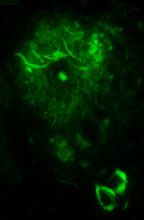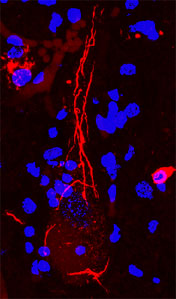Overview
 We harness modern scientific methods to advance our understanding of human disease. Molecular, biochemical and histologic techniques are able to tell us with greater detail than ever before about what is happening within cells and tissues. Our laboratory is concerned with understanding the molecular processes which contribute to aging-related neurodegenerative diseases as gleaned from molecular, biochemical and pathologic analysis of human brain and spinal cord tissues. Thus, we are developing better methods to understand neurodegenerative diseases using cutting-edge technologies across different disciplines.
We harness modern scientific methods to advance our understanding of human disease. Molecular, biochemical and histologic techniques are able to tell us with greater detail than ever before about what is happening within cells and tissues. Our laboratory is concerned with understanding the molecular processes which contribute to aging-related neurodegenerative diseases as gleaned from molecular, biochemical and pathologic analysis of human brain and spinal cord tissues. Thus, we are developing better methods to understand neurodegenerative diseases using cutting-edge technologies across different disciplines.
1449
 We change paradigms. TDP-43 is the major component of pathologic inclusions in amyotrophic lateral sclerosis (ALS) and frontotemporal degeneration (FTD). TDP-43 is an RNA-binding protein which is known to regulate pre-mRNA splicing and mRNA stability. Intronic hexanucleotide repeat expansions in C9orf72 are the most common cause of ALS and FTD, implicating toxic RNA or dipeptide repeat proteins in these clinically diverse yet mechanistically similar diseases. Tau is the major constituent of pathologic inclusions in Alzheimer's disease, trauma-related neurodegeneration, and certain forms of frontotemporal lobar degeneration. We have discovered genetic variants of VCP which cause an autosomal dominant dementia characterized by tau inclusions. Our laboratory is interested in the function and dysfunction of tau, VCP, TDP-43, and C9orf72, and in identifying the molecular pathways which are relevant to human disease.
We change paradigms. TDP-43 is the major component of pathologic inclusions in amyotrophic lateral sclerosis (ALS) and frontotemporal degeneration (FTD). TDP-43 is an RNA-binding protein which is known to regulate pre-mRNA splicing and mRNA stability. Intronic hexanucleotide repeat expansions in C9orf72 are the most common cause of ALS and FTD, implicating toxic RNA or dipeptide repeat proteins in these clinically diverse yet mechanistically similar diseases. Tau is the major constituent of pathologic inclusions in Alzheimer's disease, trauma-related neurodegeneration, and certain forms of frontotemporal lobar degeneration. We have discovered genetic variants of VCP which cause an autosomal dominant dementia characterized by tau inclusions. Our laboratory is interested in the function and dysfunction of tau, VCP, TDP-43, and C9orf72, and in identifying the molecular pathways which are relevant to human disease.
We are different because scientific progress can change who we are. Our laboratory pursues basic questions which are clinically relevant. This requires us to return to the human disease to validate our findings and to reset our trajectory. Thus, molecular, biochemical and histologic analysis of brain tissue is critical to our mission and helps guide our mechanistic studies using in vitro biochemistry, cell culture models and genetic mouse models to better understand neurodegenerative disease with an eye towards making a real impact for the patients and families we serve.

